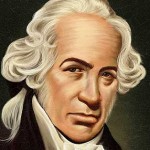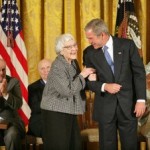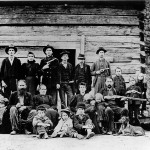Weekly Wrap Volume 69
 A Celestial Message in a Bottle
A Celestial Message in a Bottle
Imagine for a moment that it’s 40,000 years in the future in a solar system far, far, away on a planet thriving with intelligent life. Extraterrestrial beings inhabit this place. Perhaps they look like the cuddly ET, the blob, ALF, or maybe even like the dreadlocked beings from Predator; but either way, they are not human. An approaching speck in space catches the beings’ eyes (assuming they have them). Upon sending a craft to retrieve it, they find a probe containing a disk. Using instructions on the disk, they manage to play it. What they are about to hear and see are the sounds and images from an ancient alien civilization – 1977 Earth. Flashback about 40 millenia to Cornell University in Ithaca, New York, Earth in January, 1977. A brilliant, 43… (more)
 A Brief History of the Movie Rating System
A Brief History of the Movie Rating System
When you were a kid, sneaking into a rated R movie was a big deal. Everyone had their own tricks, but this author’s was to buy a ticket to a rated G Disney movie, say, Mulan; when the usher turned their back, I would run into a rated R movie like, for example American History X. But it wasn’t always this way – not kids sneaking into movies deemed only for adults, but rather the movie rating system. There was a time when movies didn’t have ratings. So how did we get from there to the current system? Thomas Edison is credited for building the first film production studio nearby his home and lab in West Orange, New Jersey in 1893. It was called Black Maria, or the “Doghouse” by Edison himself. That is where he shot… (more)
 Who Invented the Fahrenheit and Celsius Temperature Scales and What Zero Degrees Fahrenheit Signifies
Who Invented the Fahrenheit and Celsius Temperature Scales and What Zero Degrees Fahrenheit Signifies
Firmly entrenched in American society, the seemingly capricious nature of the Fahrenheit temperature scale could lead one to think that its Dutch inventor, Daniel Fahrenheit, pulled the number for the freezing point (32°F) of water out of his hat. But, in fact, its designation, as well as that of 0°F were precisely (for the early 18th century) calculated based upon deliberate choices about how to establish fixed points of temperature. Engineer, physicist and glass blower, Fahrenheit (1686-1736) decided to create a temperature scale based upon three fixed temperature points – that of freezing water, human body temperature, and the coldest point that he… (more)
 Why We Sing Auld Lang Syne on New Year’s Eve
Why We Sing Auld Lang Syne on New Year’s Eve
This tradition is mostly thanks to Guy Lombardo and the Royal Canadian Band. While their work is largely unknown to those born in the last few decades, the band has sold over 300 million records to date. Guy Lombardo himself has three stars on the Hollywood Walk of Fame, and he was once the “Dick Clark” of New Years before Clark and his “New Year’s Rockin’ Eve,” attempting to appeal to younger audiences, started supplanting “Mr. New Year’s Eve,” Guy Lombardo. It was in 1929 that Guy Lombardo and his band took the stage at the Roosevelt Hotel in New York City on New Year’s Eve. Their performance that night was being broadcast on the radio, before midnight.. (more)
 What Does the “D” in “D-Day” stand for?
What Does the “D” in “D-Day” stand for?
The Battle of Normandy, also known as D-Day, started on June 6, 1944 and was the beginning of the major invasion of German-occupied Western Europe during World War II. But why was it called “D-Day”? You might at first be inclined to think the abbreviation is similar to V-Day (Victory Day). Indeed, one commonly touted explanation given for the meaning of the “D” in D-Day is that it stands for “designated day.” Others claim it stands for “decision day”, “debarkation”, or even “deliverance day.” Even General Dwight Eisenhower, or at the least his assistant, weighed in when… (more)
Bonus Quick Facts:
- Next time you decide you’d like to just stay in bed all day and call in sick from work, simply tell your boss you’re suffering from clinomania- the excessive desire to stay in bed.
- Victor Lustig was a con-artist who managed to sell the Eiffel Tower to a scrap metal dealer and get away with it. He used forged government documents, combined with newspaper articles lamenting how expensive the tower was for the city to maintain. With the first sale, he not only was paid for the Eiffel Tower, but also managed to get a bribe by the contractor who wanted his bid to be chosen. He then fled Paris, only to return a month later when the winning contractor, Andre Poisson, didn’t report the matter to the police because of the embarrassment it would have brought. Lustig then tried to sell the tower again, this time, though, the winning bidder double checked with the authorities before paying, ultimately finding out it was a scam. However, Lustig was able to flee before he could be arrested. He was ultimately captured in America and charged with unrelated crimes after he was turned in by his girlfriend, Billy May, who had found out he was sleeping with another woman. Hell hath no fury and all that. He died of pneumonia in Alcatraz in 1947 while serving a 20 year prison sentence.
- Lucius Quinctius Cincinnatus (who Cincinnati, Ohio is ultimately named after) was out plowing his field in 485 BC when a group of Roman senators approached him to tell him Roman consul Horatius Pulvillus had nominated him as an emergency dictator of Rome (Magister Populi- “Master of the People”) after the Aequians had managed to trap the other Roman consul, Minucius Esquilinus, in the Alban Hills with his army. Cincinnatus then raised a new army and led them against the Aequians, crushing them utterly, to the point that the Aequian commander begged Cincinnatus to not slaughter them, which he granted. Cincinnatus then disbanded his army, resigned as dictator, and went back to plowing his field just 15 days after being given that powerful position that was supposed to last 6 months. Later, when Spurius Maelius was rumored to be plotting to become king of Rome, Cincinnatus was once again chosen to be an emergency dictator, and once again resigned immediately after solving the issue he’d been elected to solve (in this case after Maelius was killed when attempts were made to bring him to trial).
- Contrary to popular belief, while there are exceptions, marriage of young teen girls has never been the norm among the vast majority of cultures in history. For instance, in Medieval Europe, there is a growing body of evidence that the average age of the first marriage of a woman was between 18-22 in most areas, with urban girls in, for instance, Yorkshire, averaging closer to their mid-20s. More recently, from the 18th through the 19th centuries in England, France, and Germany, the average age for a woman to get married was about 25 years old. Across the pond in America around that time, it was closer to 21-22. After the Civil War in America, it switched to about 22-24 years old. Surprisingly, the lowest average age for first marriage since the early 1700s in United States comes from the baby boomer generation of the 20th century, who averaged 20.5 years old for women. Today, the average age in America for first marriage is 26.1 years old for women and 28.2 years old for men.
- While you’ll often read that there is a 50%-52% chance of any given marriage ending in divorce, this isn’t quite accurate, or at least doesn’t tell the whole story. It only looks at the raw figures of marriages each year vs. the number of divorces. This doesn’t take into account repeat divorcees, which skew the totals in any given year considerably. In fact, 67% of second marriages and 73% of third marriages end in divorce. The average divorce rate for first marriages is only about 41% in the United States, and these divorce rate figures have been declining significantly in the last few decades, with no signs of stopping. Further, marriages where both partners have a college degree only end in divorce about 25% of the time, even including repeat divorcees.
- Play-Doh was originally used as a wallpaper cleaner, with the compound debuting 22 years before Play-Doh hit the shelves, in a last ditch effort to save a dying company, the Cincinnati based soap company, Kutol. (Wallpaper cleaner wasn’t really used much anymore as people transitioned away from coal heat.) The woman who suggested the idea to use the compound as a toy in 1954, Kay Zufall, also suggested the name (the company originally wanted to call it “Kutol’s Rainbow Modeling Compound,” before Kay assured them that was a horrible name and suggested Play-Doh instead). In the end, Kay was given no credit in the patent nor any financial compensation for saving the company.
- Ostriches’ don’t hide their heads in the sand. In fact, they can run as fast as 45 miles per hour and sustain long distance running of about 30 miles per hour. They are also very maneuverable, using their wings to help rapidly change direction. Any predators they can’t outrun, they can often kill with their powerful kicks and huge claw on each hoof like foot, even able to kill full grown lions at times. Why they have the reputation for hiding their heads in the sand is that they have incredible hearing and vision and usually spot predators before the predators spot them. When this happens, they often lay as flat as possible against the ground to attempt to just look like a mound of dirt in the distance.
- The 30th Vice President of the United States, Charles Gates Dawes, also won a Nobel Peace Prize in 1925 and was a self-taught pianist and composer who composed the 1912 hit song, “Melody in A Major,” which was eventually used in Tommy Edwards’ 1958 #1 hit (for a then record six weeks) “It’s All in the Game.”
Other Interesting Stuff:
 The Year’s Free Wages That Resulted in the Novel “To Kill a Mockingbird”
The Year’s Free Wages That Resulted in the Novel “To Kill a Mockingbird”
The book, which was Lee’s first and only published novel, was heralded as an “instant classic” when it was published in 1960, and it is a staple in high school classrooms today. But it might not exist at all if it hadn’t been for a kind benefactor who helped to support Harper Lee while she wrote the story. Lee knew that she wanted to be a writer after developing an interest in English literature in high school. After graduation, she attended Huntingdon College in Montgomery, Alabama, where she focused on writing. However, a transfer to the University of Alabama saw a switch to a law degree—no doubt in an attempt to do something that was potentially more lucrative—before turning her… (more)
 Do Cow Farts Really Significantly Contribute to Global Warming?
Do Cow Farts Really Significantly Contribute to Global Warming?
There are currently approximately 1.3 to 1.5 billion cows grazing, sleeping, and chewing their cud at any given time on planet Earth. And these 1,300 pound (average weight for both a beef and dairy cow) animals eat a lot. Much like humans, when they eat, gas builds up inside of their guts and has to be expelled. (See Why Beans Make You Fart) Cows fart and burp… a lot. The result is a large amount of methane being introduced into the atmosphere. In a 2006 United Nations’ Food and Agricultural Organization report, it claims that the livestock sector, most of which are cows, “generates more greenhouse gas emissions as measured in CO2 equivalent – 18 percent – than transport.” According to a Danish study, the average cow produces enough methane per year to do the same… (more)
 Why So Many Health Issues Stem from Problems in the Thyroid
Why So Many Health Issues Stem from Problems in the Thyroid
It seems like just about everyone knows someone with a thyroid condition. Their symptoms can sometimes be wide ranging. Much like the IRS and their tax code, it can leave you a little confused about what exactly it does and why it can cause so many problems. In an effort to put this ignorance to bed, let’s take a little closer look at this inexplicable little endocrine gland. The thyroid is the largest independent endocrine gland in the body. It’s butterfly shaped and wraps around the front part of your trachea (your wind-pipe) just below the Adam’s apple. (If you’re curious- see Why the Adam’s Apple is Called That) The thyroid secretes hormones that affect almost every cell in your body. In fact, only… (more)
 The Real Feud Between the Hatfields and McCoys
The Real Feud Between the Hatfields and McCoys
As with a lot of historical events, Hollywood has glamorized and largely fictionalized the feud between the Hatfields and the McCoys. So what really happened? It is believed that both families came to America before it was even America. The Hatfields were among the first pioneers to make their way to this new land from the shores of Yorkshire in northern England. The first Hatfield was Matthias Heathfield, who settled in New Haven, Connecticut around 1660. It would seem that the name was slightly altered by Matthias’ descendents, either his children or grandchild, to forever be “Hatfields.” The McCoys… (more)
 Super Glue was Invented by Accident, Twice
Super Glue was Invented by Accident, Twice
Super Glue, also known as cyanoacrylate, was originally discovered in 1942 by Dr. Harry Coover, who by the way died last month on March 26th, 2011. Coover was attempting to make clear plastic gun sights to be put on guns used by Allied soldiers in WWII. One particular formulation he came up with didn’t work well for gun sights, but worked fantastically as an extremely quick bonding adhesive. Surprisingly, despite the commercial potential of such a product, Coover abandoned that formulation completely as it obviously wasn’t suitable for his current project, being too sticky. Nine years later, in 1951, now working at Eastman Kodak, Dr. Coover was the supervisor of a project looking at developing a heat resistant acrylate polymer for jet canopies. Fred Joyner was working on that project and at one… (more)
This Week’s Podcast Episodes:
- Podcast Episode #306: Dropping the Ball
- Podcast Episode #307: Auld Lang Syne
- Podcast Episode #308: How January 1st Became the New Year
- Podcast Episode #309: The Bermuda Triangle
- Podcast Episode #310: The Invention of the High Five and the First Openly Gay Major League Baseball Player
Quote of the Week:
- “Here eat this cereal covered in my vomit” – the Honey Nut Cheerios bee
| Share the Knowledge! |
|




